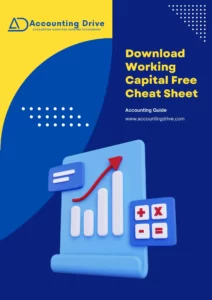Working capital or cash conversion cycle? How confusing is it….
What exactly are the working capital and cash conversion cycle? Are they the same term or different?
So, let’s explore it with me…
Simply, Cash Conversion Cycle is the time period required to make more money from the available money- a complete process of creating goods or services by using the available money or resources and selling it to generate additional money until its collection. Whereas Working Capital is the required amount to keep the business solvent during the time duration of the Cash conversion cycle in which cash is tied up in the process.
- Working Capital is the amount you needed to operate your day-to-day business operations.
While Cash Conversion Cycle shows the time duration in which working capital tied up the available cash for doing business operations.
Let’s first explore these two terms- working capital and cash conversion cycle in detail.
Working Capital- WC
In This Article
ToggleSimply put, Working Capital is that liquid money available to satisfy your day-to-day short-term financial obligations.
Working Capital (WC) Formula
Working Capital = Current assets – current liabilities
Get Free access to the AD's working capital cheat sheet
Grab your cheat sheet now by clicking the button !!
Cash Conversion Cycle- CCC
The Cash Conversion Cycle is the time duration in which Cash flows convert resources like input- money or investment into an output- sales. In short, the metrics expressed time in three sorts of days- DIO, DSO, and DPO.
Its standard calculating formula is:
Cash Conversion Cycle (CCC) Formula
CCC = DIO + DSO - DPO
- DIO stands for Days inventory outstanding
- DSO stands for Days sales outstanding
- DPO stands for Days payable outstanding
Meanwhile, let’s have a quick grasp of what exactly are DIO, DSO, and DPO and how to calculate them.
Days Inventory Outstanding (DIO)
It is defined as the sum of the days a firm takes to sell its inventory or the total holding period required to convert raw material into finished goods and then its sale. A shorter period for DIO is preferable because it shows that the company can sell its finished good rapidly and eventually leads toward a reduced cash conversion cycle.
Here, you can see what is the standard formula for calculating DIO:
DIO = (Average inventory/ Cost of goods sold) * 365
Days Sales Outstanding (DSO)
Days sales outstanding is defined as the sum of days a firm takes to collect its cash- stuck in its receivables from customers. Same as DIO- A shorter period is preferable because it shows that the company is collecting tied-up cash faster. Moreover, the shorter the DSO will improve the cash conversion cycle. If your company is making only cash sales, it means your DSO is zero. But, to increase revenues, trade credits are common practice. Commonly, companies are maintaining a 40:60 ratio for cash and credit sales to increase profitability.
The standard formula for calculating DSO:
DSO = (average account receivable / total credit sales) * 365
Days Payable Outstanding (DPO)
It is defined as the total number of days the company takes to pay off its account payables. It must be larger which displays the company’s strategic approach toward holding its cash for further investments.
You can calculate DPO with the help of using the following formula:
DPO = (average account payable/ Cost of goods sold) * 365
Example- Working Capital vs Cash Conversion Cycle
Let’s identify the relationship between the working and cash conversion cycle with the help of the following example.
Let’s assume Ronald AK is a growing company doing business as let’s say buy or sell inventory. Hence, the required information has been collected from Ronald AK’s financial statements.
| 2020 (in millions) | 2019 (in millions) | |
| Credit Sales | $ 5690 | $ 4590 |
| COGS | 3290 | 2990 |
| Inventory | 320 | 300 |
| Account receivable | 500 | 450 |
| Account Payable | 450 | 400 |
| Average Inventory | $ (320+300)/2 = 310 | |
| Average Account receivable | $ (500+450)/2 = 475 | |
| Average Account Payable | $ (450+400)/2 = 425 | |
| DIO | $ (310/ 3290) *365 = 34 days | |
| DSO | (475/ 5690) *365 = 31 days | |
| DPO | (425/ 3290) *365 = 47 days | |
| Current assets | $ 320+ $ 500 = $ 820 million | $ 300+ $ 450 = $ 750 million |
| Current liabilities | $ 450 million | $ 400 million |
From the above information, you can easily calculate working Capital and Cash Conversion Cycle.
Working Capital = Current assets- current liabilities
= $ 820 million – $ 450 million
= $ 370 million
Cash Conversion Cycle = DIO+ DSO- DPO
= 34 days + 31 days – 47 days
= 18 days
Explanation- Working Capital and Cash Conversion Cycle
So, it could be seen that the concept of working capital is distinct from the cash conversion cycle concept. However, these two terms are interrelated and part of the company’s operating mechanism. A major part of CCC and WC are comprised of the same operating items- inventory, receivables, and payables. Ronald AK’s CCC is 18 days indicating it requires 18 days to complete the process from purchasing of inventory, selling, and collecting payment from customers. To keep the business solvent, Ronald Ak maintains a working capital of 370 million to support its business’ day-to-day operations during these 18 days’ time duration in which cash is tied up in the process.
Hence, the minimum cash conversion cycle, eventually the minimum external capital will require. Amazon and Wall-Mart are actually maintaining a negative Cash conversion cycle and negative working capital by following an effective credit collection policy and receiving cash-up-front payments from customers. But negative CCC requires an efficient strategic approach, otherwise, it will yield serious long-term financial harm to the business.
Best benchmark- CCC
45 days is an excellent benchmark for CCC- How? Here, a question clicked in my mind why short one CCC is good?
So, the answer is- it reflects that your inventory management is good, you collect accounts receivable in minimum days, and your lender will not hesitate to lend you because it reflects that you have enough working capital to meet your current obligations. It is good to minimize the cash conversion cycle. So, you can improve your CCC by increasing DPO- as DPO is the only element in the CCC that have negative relation. Increased DPO indicates that you hold cash for a longer period of time by delaying payments to suppliers. Moreover, reduced DIO and DSO minimize CCC, as DIO and DSO have positive relationships. Faster sales and quicker collection of accounts receivable reduce CCC.
Thus, both- working capital and cash conversion cycle are important metrics for examining the firm’s liquidity position. As WC and CCC have the same major operating components, thus by CCC can be improved by following effective working capital management strategies.
Key Points
- These two- Working Capital and Cash Conversion Cycle are distinct terms.
- The cash conversion cycle is the time duration for completing the process, whereas working capital is the amount you needed to keep the business solvent.
- The lower the cash conversion cycle, the better for business operations.
- Forty-five days of cash conversion cycle is the best benchmark for growing a business.
- The minimum cash conversion cycle reduces the working capital requirements.
- A larger cash conversion cycle increases the dependence on external capital.
Recommended Articles
Cash Flow Statement Template
Get Free Access to AD’s easy to use Cash Flow Statement Template



